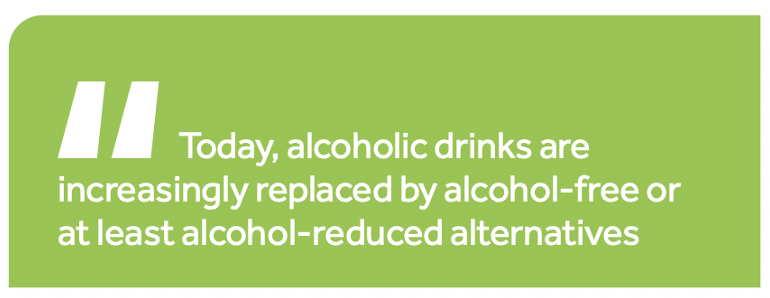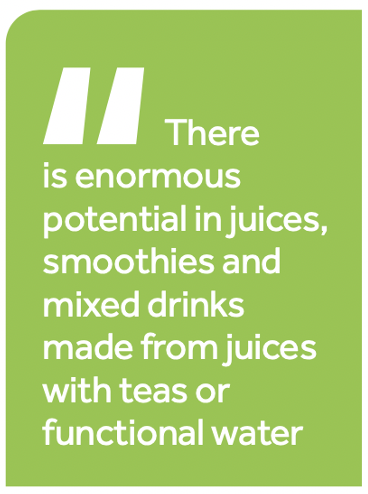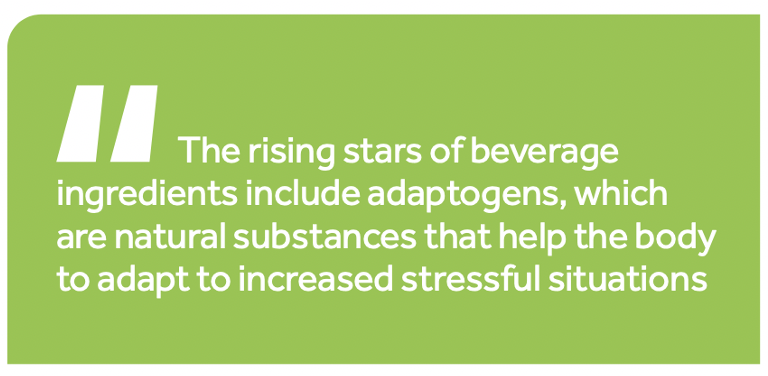Today, people want to be productive and at the same time feel healthy and well – not just physically, but mentally. Diet plays a crucial role in this. It’s obvious that juice today is much more than just a thirst-quencher.
While health and wellbeing have never been as high on the list of values of global consumers as they are today, the hit list of drinks has also changed dramatically in recent years.
Not long ago, beer, wine, champagne, sparkling wine, cocktails and long drinks were simply a part of enjoying parties, private celebrations and relaxing evenings at home.
Today, alcoholic drinks are increasingly replaced by alcohol-free, or at least alcohol-reduced, alternatives. ‘Mocktails’, for example, are the non-alcoholic successors to cocktails – and juices made from a wide variety of fruits and berries are the main players in their preparation.
But that’s not all, consumers all over the world are not only looking for healthy ‘free-from’ drinks, but also for drinks that actively promote their health. Today, they search for holistic solutions that help them change their lifestyle in all areas of life. Food and drink ingredients should be natural and, ideally, organic. They should be sustainably produced, unique taste and provide the ‘wow effect’. The value for the body or mind should also be targeted and clear. Juices play an important role, with their flavours and valuable ingredients.

Mixed Juice Drinks for Relaxation and Concentration
There is enormous potential in juices, smoothies and mixed drinks made from juices with teas or functional water for holistically improving health and meeting the needs of modern consumers. The demand for products like this is increasing worldwide. According to the market research institute, Mintel, 40% of adults in Chile and Australia state that their diet should also raise their energy level; in India, 49% share this opinion. Worldwide, 52% of consumers are interested in products that help reduce stress. 45% have changed their diet with the aim of improving their sleep, especially since sleep problems are becoming more and more common due to the increasing occurrence of stress, depression and anxiety.
Herbs and herbal ingredients are said to clearly affect health: 60% of consumers worldwide are of the opinion that botanicals have a positive effect on their health. This is why the use of juices, in combination with ingredients such as chamomile, lavender or hops, which improve sleep and relaxation, is increasing in the development of beverages in the functional drinks category.
The addition of B vitamins, adaptogens and nootropic substances promotes concentration and alertness and antioxidants help detoxify.
Stand Out Ingredients
The rising stars of beverage ingredients include adaptogens, which are natural substances that help the body to adapt to increased stressful situations without having an overstimulating effect. CBD, turmeric, ginseng, roseroot and ashwagandha are certainly the best-known examples that are more and more finding their way into the recipes of beverage manufacturers.

Juice Drinks Strengthen the Immune System and Eye Health
Since COVID-19, strengthening the immune system has also climbed the list of priorities of consumers. Therefore, citrus and berry juices come into focus because of their high vitamin C and antioxidant content. Likewise, consumer demand for fast, nutritious food and beverage solutions, which are available in the form of clean label juice shots, is also increasing.
Since people nowadays usually spend several hours in front of different kinds of screens – professionally and privately – the attention towards eye health is rising: Vitamin A, zinc, riboflavin or DHA can be added to juices to specifically promote eye health. Carrot juice is also suitable here because it contributes to a healthy lifestyle and supports eye health with vitamin A naturally.
Hydration with Less Fruit Juice Content but Full Flavour
For the participants of a worldwide survey by Mintel, ‘healthy’ means – among other things – that food contains no artificial ingredients and little fat. It also means they are a good source of vitamins and minerals and have low calories and a high fibre content. As a result, soft drinks with a high-water content and a lower juice content continue to have potential on the market, due to lower calories and the valuable ingredients of juice.
Additionally, sugar reduced juice concentrates come into play nowadays in beverage developments, too. The new success factor for beverages and juices are also (new) taste experiences.
Taste Experience
‘Taste Experience’ is a current megatrend that is impressively shaping the world of the food and beverage industry. It’s about pure consumer experiences, about taking the consumer on an adventure triggered by sensory, visual and haptic experiences. Unusual, spicy or exotic flavour combinations, which especially in times of COVID-19 and travel restrictions conjure a bit of travel-flavour into the glass at home, ensure new taste adventures. The possibilities for using fruit and vegetable juices are therefore diverse, in terms of taste and concept.
New Beverage Concepts Require Know-How
The development of new beverage concepts, especially with the use of fruit and vegetable juices, brings challenges that require appropriate market knowledge and extensive know-how for the exact matching of ingredients. Products with fruit juice often have a complex product matrix. They contain water, fruit juice, sugar, aroma, food colouring, vitamins, edible acids, stabilizers, and so on. Even the smallest adjustments to the dosage of an ingredient can make the difference between a completely unstable product or a perfectly stable one. For example, in terms of taste, it is important to prevent flocculation, cloudiness, sedimentation or rapid product ageing. Depending on the ingredient, external influences, such as temperature or UV radiation, must also be taken into account.

Stabilising the Drinks
In the case of alcoholic beverages, such as mixed beer beverages, cider or hard seltzer, the interaction of the alcoholic base such as beer, cider and fermented glucose with fruit juice makes it difficult to stabilize the drink. The following (roughly) applies here: the higher the alcohol content, the higher the risk of flocculation. Low alcohol contents, of up to 2.5% ABV, are often not a major problem. Stabilizations above that are also possible.
Long-term reproducibility also plays an important role for all industrially produced beverages. The standardization of the raw materials is essential, so the juices are expertly blended from different qualities after the harvest in order to guarantee the consumer a consistent quality.
At Austria Juice, the know-how is bundled in one source – from market research to the beverage concept, from fruit growing to the finished recipe and ingredient supply. In this way, we offer our customers the best possible support for their diverse projects.

Other Opinions You May Be Interested In…
- Fruit Juice Focus: Poland: It’s More Than Just Apples
- Fruit Juice Focus: USA Juice Market Update
- Fruit Juice Focus: Putting the ‘Great’ into Pineapple Juice














